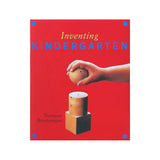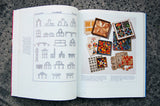This 2014 revised edition of Brosterman's 1997 New York Times Notable Book features stunning photographs to illustrate the beauty of Froebel's original Kindergarten materials. The well-researched text shows how modern art was sparked by Kindergarten. Hardcover, 160 pages.
“The juxtaposition here of nineteenth-century kindergarten work with the work of Braque, Klee, Mondrian, and Frank Lloyd Wright will make you gasp. This is a revelatory book.” — The New Yorker
“How completely splendid that here it is, back easily available to all who could benefit from reading it, which is to say just about anyone. For indeed, Brosterman’s inspired feat of educational archeology is vitally essential in at least two senses: in helping us to imagine—or rather to recall, to recover—an early childhood schooling model steeped not in reading, writing and ’rithmetic (and the frantic drilling and testing and tracking thereof), but rather in pattern delight and guided play; and then secondly—talk about patterns!—in helping us to recognize, as if from scratch, how crucial this sort of education, widespread and common throughout the world in the late 19th century, proved to be in incubating so many of the fundamental modernist breakthroughs (in painting and sculpture and architecture, though one suspects in the sciences as well) that the veterans of such preschooling were to make during the first quarter of the century that followed. And the book is itself a continual page-turning delight.” — Lawrence Weschler, director of the New York Institute for the Humanities at NYU, author Mr Wilson’s Cabinet of Wonder and Uncanny Valley: Adventures in the Narrative
“The juxtaposition here of nineteenth-century kindergarten work with the work of Braque, Klee, Mondrian, and Frank Lloyd Wright will make you gasp. This is a revelatory book.” — The New Yorker
“How completely splendid that here it is, back easily available to all who could benefit from reading it, which is to say just about anyone. For indeed, Brosterman’s inspired feat of educational archeology is vitally essential in at least two senses: in helping us to imagine—or rather to recall, to recover—an early childhood schooling model steeped not in reading, writing and ’rithmetic (and the frantic drilling and testing and tracking thereof), but rather in pattern delight and guided play; and then secondly—talk about patterns!—in helping us to recognize, as if from scratch, how crucial this sort of education, widespread and common throughout the world in the late 19th century, proved to be in incubating so many of the fundamental modernist breakthroughs (in painting and sculpture and architecture, though one suspects in the sciences as well) that the veterans of such preschooling were to make during the first quarter of the century that followed. And the book is itself a continual page-turning delight.” — Lawrence Weschler, director of the New York Institute for the Humanities at NYU, author Mr Wilson’s Cabinet of Wonder and Uncanny Valley: Adventures in the Narrative






